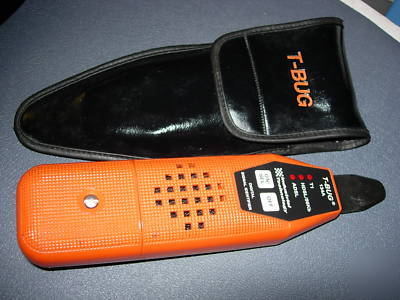EXCLUSIVE FORUM FOR MACHINE DISMANTLERS AND REPAIR PEOPLE > East Chicago
> t-bug digital signal identifier model 134A
t-bug digital signal identifier model 134A
Industrial Technology T-Bug Model 134A
This tester is in great condition and works perfect.
Locate circuits carrying digital signals. Now detects ADSL .
The T-Bug is simple to operate and constructed for rugged field use. Operation is non-intrusive and does not involve metallic contact so working digital circuits can be identified without risk of service interruption.
Use in the Field or Central Office
The T-Bug can be used either in the field, Central Office or other locations by technicians in OSP construction, maintenance, or special services during operations such as cable transfers, section replacements and cable testing. It can be used at the main frame, in a splice, pedestal, cross-connect box, or remote terminal.
The T-Bug will detect digital signals in several frequency bands. including T1/E1, HDSL and ADSL. See Specifications for bit rates detected.
Listen to the Actual Bit Stream
The T-Bug provides both an audible and visible indication when digital signals are present on a cable pair. The visible indicator is the red LED which brightens in proportion to the signal strength encountered. The audible indicator is the sound of the actual digital signals being transmitted on the pair which are reduced to audible range through the T-Bug s unique hetrodyne receiver. By listening to the actual bit stream on the pair, a technician can detect the type of signal present.
Another feature unique to the T-Bug is its differential probe. This allows a technician to determine whether the digital signals detected are truly present on a pair, or merely induced signals from adjacent pairs. When the T-Bug probe tip is placed between the ring and tip (A and B) of the pair, metallic signals between the ring and tip are enhanced while induced common mode signals are cancelled out. In addition, false readings due to noise are virtually eliminated.
The ON/SEL pushbutton turns the unit on for approximately 200 seconds and automatically checks the battery. When turned on, the T-Bug will tick once per second. The tick tells the user the T-Bug is on and also serves as a continuous self-test, assuring the user that the unit is functioning properly.
With the unit on, the probe end is placed against the pairs in question. If digital signals are present, the T-Bug will emit an audible and visible indication. Both indica-tions get stronger as the T-Bug gets closer to the signal source making it easy to isolate the digital pairs.
To confirm digital signals on a suspect pair, simply place the probe tip between the ring and tip of the pair. If the signal increases, there is a digital source present. If the signal decreases, it is a coupled signal and not a true carrier
Size: 9.4 x 2.1 x 1.6 inches (24 x 5 x 4 cm)
Power: One 9V NEDA 1604 battery (spare supplied)
Battery Life: 350 Power On cycles per battery minimum
Bit Rates and Carrier Types Detected:
T-Bug Digital Signal Identifier, Model 134A
detects 1.544 Mb/s carriers which include T1, SLC-96, DMS-1 Urban, MS-43 and Primary Rate ISDN
detects 56 Kb/s and 64 Kb/s carriers, which include DDS, HDSL and Basic Rate ISDN
detects ADSL-DMT per ANSI T1.413
E-Bug Digital Signal Identifier, Model 135A
detects 2.048 Mb/s carriers which include E1 with HDB3 line coding, and other carriers based
detects 56 Kb/s and 64 Kb/s which include DDS, HDSL and Basic Rate ISDN

